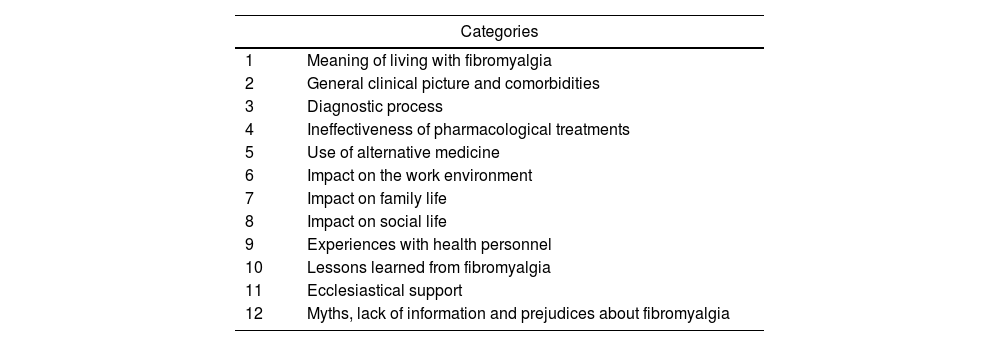Patients with fibromyalgia experience pain at a constant and incapacitating pace. It is still a complex entity yet to be fully understood but meanwhile affects patients in every aspect of their lives.
ObjectiveThe purpose of this study is to describe what living with fibromyalgia means for Peruvian women and how it affects their family, work, and social lives in 2021.
Materials and methodsThe study has a qualitative design with a phenomenological approach; snowball sampling and theoretical saturation sample size; 10 patients were interviewed through semi-structured in-depth interviews. An ideographic and a nomothetic analysis were conducted, divergences and convergences in the statements were sought and units of analysis were obtained.
ResultsThere were 12 categories: meaning of fibromyalgia, clinical picture, complications and sequelae, diagnostic process, impact on work, impact on family life, impact on social life, experience with health personnel, lessons learned from fibromyalgia, ecclesiastical support, and myths, misinformation, and prejudices about fibromyalgia.
ConclusionThe experiences and the clinical picture are diverse, the family remains an active and reliable support network for patients, unlike social and work lives, where there is a lack of initiative or empathy towards patients. In light of our findings, we expect healthcare workers and the public in general to learn and see beyond “just histrionics” or “attention seekers” and thus improve the patient's quality of life.
Los pacientes con fibromialgia experimentan dolor a un ritmo constante e incapacitante. Esta es una entidad compleja, parcialmente comprendida, que afecta todos los aspectos de la vida del paciente.
ObjetivoEl propósito de este estudio es describir el significado de vivir con fibromialgia para las mujeres peruanas, y cómo afecta su vida familiar, laboral y social en el 2021.
Materiales y métodosDiseño cualitativo con enfoque fenomenológico; muestreo de bola de nieve y tamaño de muestra por saturación teórica; se entrevistó a 10 pacientes por medio de entrevistas en profundidad, semiestructuradas, y se aplicó un análisis ideográfico y nomotético; se buscaron divergencias y convergencias en los enunciados, y se obtuvieron unidades de análisis.
ResultadosSe encontraron 12 categorías: significado de la fibromialgia, cuadro clínico, complicaciones y secuelas, proceso diagnóstico, impacto en el trabajo, impacto en la vida familiar, impacto en la vida social, experiencia con el personal de salud, lecciones aprendidas de la fibromialgia, apoyo eclesiástico y mitos, desinformación y prejuicios sobre la fibromialgia.
ConclusiónLas experiencias y el cuadro clínico son diversos, la familia permanece como una red de apoyo activa y confiable para los pacientes, en contraste con el entorno social y laboral, que no muestran empatía hacia los pacientes. A la luz de nuestros hallazgos, esperamos que los trabajadores de la salud y el público en general aprendan y vean este problema más allá de conceptos como «solo histrionismo» o «buscadores de atención», y así mejorar la calidad de vida del paciente.






